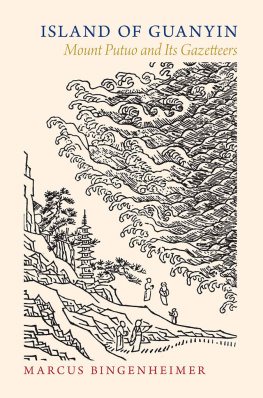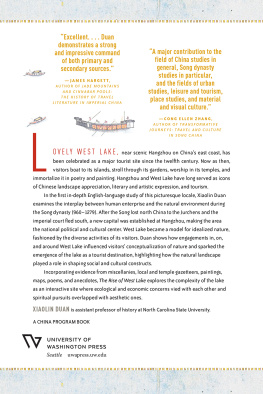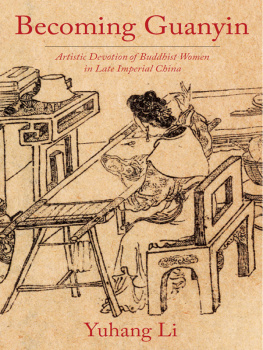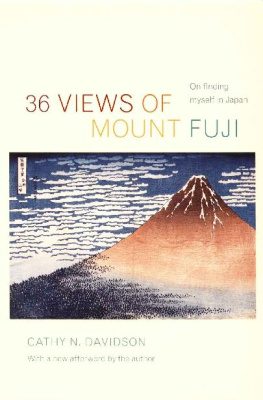Island of Guanyin

Budaluojia guanyin xianshen shengjing (c. 1350).
Island of Guanyin
Mount Putuo and Its Gazetteers
MARCUS BINGENHEIMER


Oxford University Press is a department of the University of Oxford. It furthers the Universitys objective of excellence in research, scholarship, and education by publishing worldwide. Oxford is a registered trade mark of Oxford University Press in the UK and certain other countries.
Published in the United States of America by Oxford University Press
198 Madison Avenue, New York, NY 10016, United States of America.
Oxford University Press 2016
All rights reserved. No part of this publication may be reproduced, stored in a retrieval system, or transmitted, in any form or by any means, without the prior permission in writing of Oxford University Press, or as expressly permitted by law, by license, or under terms agreed with the appropriate reproduction rights organization. Inquiries concerning reproduction outside the scope of the above should be sent to the Rights Department, Oxford University Press, at the address above.
You must not circulate this work in any other form and you must impose this same condition on any acquirer.
Library of Congress Cataloging-in-Publication Data
Names: Bingenheimer, Marcus, author.
Title: Island of Guanyin : Mount Putuo and its gazetteers / Marcus Bingenheimer.
Description: New York : Oxford University Press, 2016. |
Includes bibliographical references and index.
Identifiers: LCCN 2015034121 | ISBN 9780190456191 (hardback : alk. paper) | eISBN 9780190614157
Subjects: LCSH: Buddhist templesChinaPutuo Shan Island. | Putuo Shan Island (China)Description and travel. | Putuo Shan Island (China)History.
Classification: LCC BQ6345.P82 B56 2016 | DDC 294.3095124/2dc23 LC record available at http://lccn.loc.gov/2015034121
CONTENTS
This book started out as a project to digitize a collection of mountain and temple gazetteers. From 2007 to 2011, the Digital Archive of Buddhist Temple Gazetteers (http://buddhistinformatics.ddbc.edu.tw/fosizhi/) was funded by the Chung-hwa Institute of Buddhist Studies and created with the help of many friends, among others: Ray Chou, Jenjou Hung, April Ke, Axian Lee, Miao Lin, Xiuli Lin, and Chuanqin Peng. To date it contains text and images of more than 230 gazetteers. So much new information was added to the digital texts of some gazetteers that in a follow-up project we decided to produce improved print editions of them with detailed indices, annotation, and new punctuation. In 2013, twelve gazetteers were published as The Zhonghua Collection of Buddhist Temple Gazetteers (Taipei: Shin Wen Feng). The two gazetteers on Mount Putuo in that collection were especially valuable to me and will be often cited here. Having been interested in Buddhist historiography for some time, I was naturally curious as to how the gazetteers depicted a sacred Buddhist site over time. What comes into focus and what is obscured by looking at a sacred site through the lens of its gazetteers?
The book itself was written between 2012 and 2015, when I enjoyed working with my colleagues and the graduate students in the Department of Religion at Temple University. I am grateful for their company.
The study was helped in many ways by Chn-fang Ys groundbreaking work on Guanyin, and I am very fortunate to have received Professor Ys support in my own efforts to understand the manifestations of the Bodhisattva. Her help and advice in the publication process is gratefully acknowledged. It was wonderful to work with Cynthia Read and Gina Chung at Oxford University Press, who skillfully managed the review and production process. Reviews by two anonymous readers provided new perspectives and led to significant additions to the manuscript.
Drafts of chapters were presented at several conferences and lectures over the last few years. Thanks to all who came to listen and cared to comment.
Some friends and colleagues have read parts or even all of the manuscript, and their insightful comments and suggestions saved me from many embarrassing mistakes. Special thanks therefore go to Wendi Adamek, Jinhua Chen, Douglas Gildow, Sujung Kim, Karen Kingsbury, Tingyu Liu, Pierce Salguero, Ting Shen, and Simon Wiles.
Many other friends and colleagues have in various ways contributed by answering questions, sending info, making one of those small remarks that change everything, or just by lending a patient ear: Susan Andrews, Timothy Brook, Sara Chiesura, Wen-shing Chou, Douglas Duckworth, Hilde De Weerdt, Shih-shan Susan Huang, Weining Huang, Venerable Huimin, Seinosuke Ide, John Kieschnick, Chaoheng Liao, Wendy Lochner, Karen Lucic, William Magee, Justin McDaniel, Max Moerman, Christine Moll-Murata, Joseph OLeary, James Robson, Stephen F. Teiser, Christian Wittern, Li Wei, and Dorothy Wong.
Island of Guanyin is dedicated to all those who try to be compassionate like Guanyin.
Island of Guanyin
To a degree the book replicates the structure of a gazetteer andwith the exception of this introductionit is organized by genre in the way gazetteers are. After a chapter on prefaces there follow chapters on maps, miracle tales, landscape, biographies, inscriptions, poems, and travelogues. Each of the eight chapters is a variation on a certain type of record that appears in gazetteers as part of the feedback loop between text and site. In this loop, text is made manifest in landscapes, architecture, or practices, and these in turn are shaped by various interests, by loss and increase, until they are again recorded as text. Gazetteers are important for understanding the ways in which sacred sites are constructedtextualizedin a multiplicity of genres. As they document the textualization of sacred space through prefaces, maps, miracle stories, poems, biographies and other forms, the information about a single person, event, or place is often found scattered across different chapters. Thus, in their own disjunctive and encyclopedic manner, gazetteers deny any single genre the power to provide a unified viewpoint from which to observe events and explain their causes. At the same time, the gazetteers often preserve rare sources that allow us to examine the history of Chinese Buddhism, especially of the last five hundred years, in great detail.
Using the gazetteers of Mount Putuo as a case study is, I believe, a reasonable choice. For Mount Putuo we have nine extant gazetteers, the first dated 1361sufficient material to observe how the depiction of the site has evolved over time. Furthermore, Mount Putuo is a truly significant site. Throughout the last millennium it was widely known in China as a center of Buddhist pilgrimage dedicated to the Bodhisattva Guanyin (Skr. Avalokitevara)one of the most popular deities in East Asia who is widely worshipped in China, Tibet, Mongolia, Korea, Japan, Taiwan, and Vietnam.
My aim is to show how gazetteers operate and how different generations of gazetteers reflect changes in the site and the circumstances of their production. To this end each chapter focuses on one genre, presenting and discussing examples taken (mostly) from the gazetteers of Mount Putuo. Individual texts are framed as exhibits, and readers are invited to walk through the chapters of the book as they would through rooms in a museum. The genres are arranged in the order in which they would typically be found in gazetteers, but, as in a real museum, the rooms and exhibits in this gazetteer can be explored out of numerical order. Readers interested in how poems, for instance, are used in gazetteers might proceed directly to .












